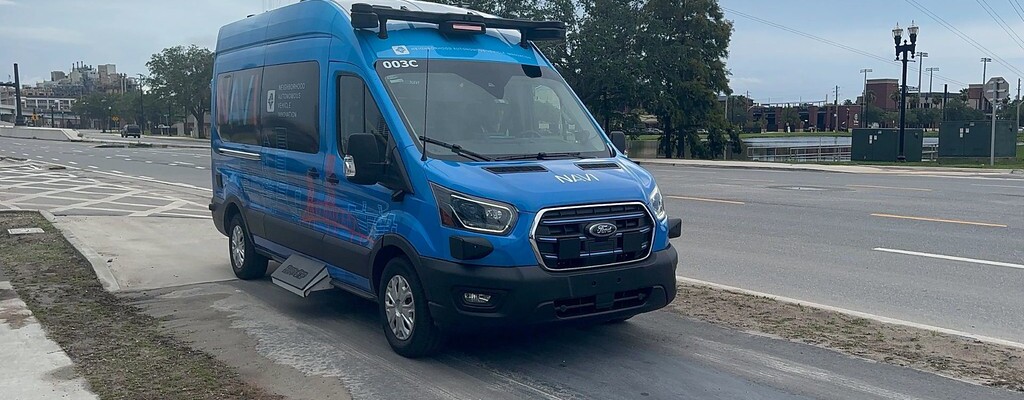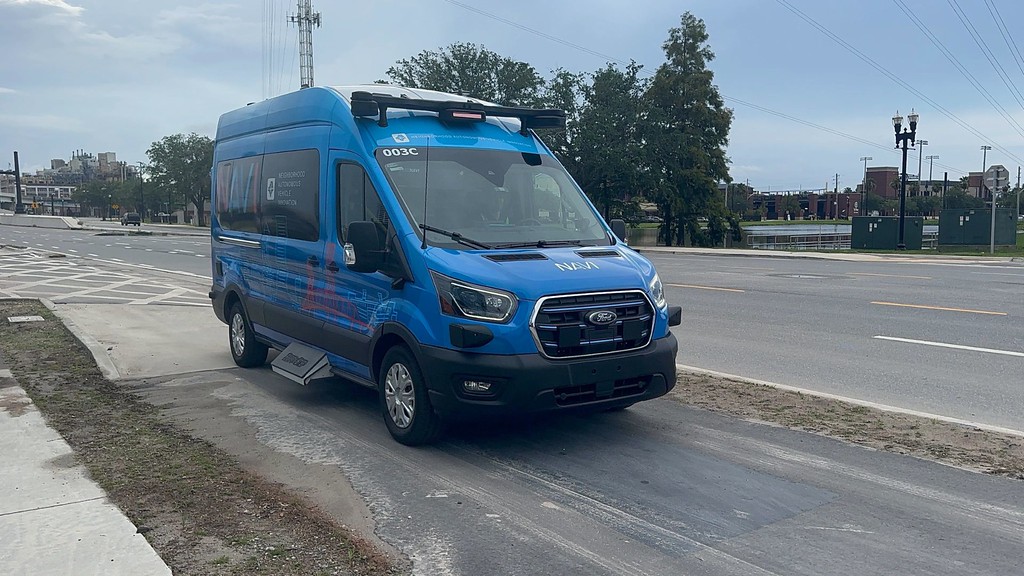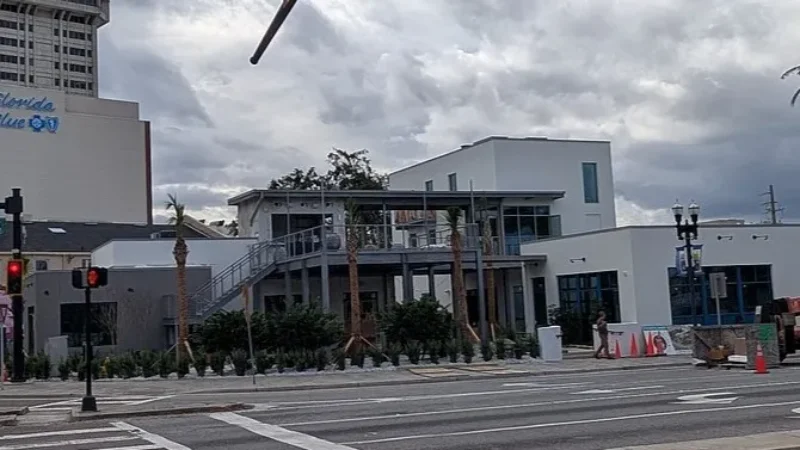
I decided it was important to see what all these years of work and millions of taxpayer dollars had gone into, and I figured there’s no better way to do that than to get up close and personal, so I took some time on July 3rd to make my way to Downtown Jacksonville and try out NAVI myself, along with a number of friends watching live from my phone.
I’m… stunned. And not in a good way.
For comparison, I first rode the Skyway monorail from Jefferson Station to Rosa Parks and then back to Central Station. Along the way I noticed that there were a variety of people using it, mostly workers on this Thursday afternoon but also families using it to get around Downtown. The Jacksonville Transportation Authority only appears to have two Skyway trains in service, one for each side of the river, with trains about every 15 minutes. The stations seem reasonably well maintained but the trains, some now bordering on 30 years old, are clearly getting into dire shape.
From Central Station, I crossed the street to Bay & Julia to board NAVI. A man appeared to be smoking at the station, but walked away as I approached. The station is quite designed, with a lot of what appear to be frosted glass panels, including a big one on top with a stylized JTA arrow. I’m not sure if they have a warehouse full of replacement panels or if that’s just not going to last.

On the opposite side of the pedestal that included an upcoming buses screen (which lacked a line for NAVI) and a smaller touchscreen with a camera for communicating with the AIC, there’s a screen that appears to be solely dedicated to broadcasting promotional content about the system, including footage of the vehicles testing down at SunTrax in Central Florida and a clip of Councilman Rahman Johnson. There are also buttons to request a wheelchair ramp or call for help. Once fare collection ($1.75 per ride) begins in October, there’s a card reader on a smaller pedestal next to the station for off-board payment. They appear to not accept American Express.

The first NAVI vehicle to arrive was out of service with a sheet of paper labeling it as such, and the man inside appeared to drive off. The second was in service and allowed me aboard. The Beep employee in the driver’s seat was friendly, the giant computer box in place of the front passenger less so.
The passenger area of the vehicle is fully wrapped, meaning the view outside is rather poor. There are nine seats facing inward, six usable if someone in a wheelchair boards with the lift, which takes up a lot of interior room and is covered with a panel that includes another touchscreen and another promotional screen above it, with some safety information as well.

There’s another fold-down screen up front that displays announcements and shows upcoming stops. In addition to the van’s infotainment screen (repurposed for some kind of operating display), there’s a smaller screen left of the Beep employee that shows the status of the autonomous kit: Auto, Ready, Ready (Stationary), Stowed, or Manual.
Before we could move, I was told I needed to sit and buckle myself. This appears to be required for all passengers. The Beep employee seems to control both the doors and the hazard lights, possibly also turn signals (that was hard to see from the passenger area).
There are now a number of transit-only signals along the route, in addition to sensors above traffic poles and a scattering of NAVI-branded signal control boxes.
Once we began to move, some challenges quickly became apparent. The vehicle needs to move from the north side of Bay Street (where the station is) to the south side in less than a block in order to turn south onto Pearl Street. It’s hard to tell if the autonomous kit is capable of making this movement itself or requires help from the Beep employee. Along Water Street and Independent Drive, I was watching the small screen flicker between Auto, Manual, Ready, and Stowed as it moved eastward and stopped at Riverfront Plaza.
There were also a number of sudden stops as it moved, which seemed to explain the need for seat belts. These awkward movements continued as we moved onto Bay Street, where the vehicle swerves into traffic as it tries to avoid the parked cars near the former courthouse.
The ride is quite noisy, between the whine of the electric motors, the frequent automated announcements, and radio chatter from the AIC.

Just east of Lafayette Street, where Bay separates to accommodate the Hart Ramps, the vehicle moves onto a (rather badly paved) dedicated lane built between Gator Bowl Boulevard and its sidewalk. This includes a very strangely positioned stop that the vehicle essentially stops past (already listed as being for MOSH), and another stop across from Lot J (listed as the Four Seasons). At most of these stops, the vehicle would stop, but not open the doors. The vehicle then proceeds further east (through a puddle, today) before finally reaching the pedestrian crossing near Daily’s Place, where it makes a U-turn to proceed back west down Gator Bowl Boulevard. There is another stop (for the stadium, with the outdated name of “TIAA Field”), where I temporarily got off and walked around.
I crossed the street back to the Four Seasons station, where after a strangely long wait (the pedestal screen, which now did include NAVI arrivals going from 4:09 to 4:12 and eventually to 4:19) before being met by the very same vehicle I had exited earlier, this time with another Beep employee aboard who exited to apparently examine something before re-boarding. We then made a large U along Georgia Street, Duval Street, and then A. Philip Randolph Boulevard (where one station appeared to still be under construction) before rejoining Bay Street.
As we passed the Elbow, the Beep employee had to take over to pass two double-parked beer trucks, the system taking back over at Market Street. The second Beep employee explained how he had only begun working back in February, discussing how the vehicle was still overly cautious and employees would need to help it along, especially around construction, which hopefully would make things easier after that work was completed.
There were only four vans operating at that time, and with this being a Thursday afternoon and tomorrow a holiday, it would be the last day of operation before the following Monday morning. He seemed to suggest that the hours might potentially expand later. I asked about how they would accommodate people leaving busy events such as football games as fall rolls around. His answer was only that they would simply keep running the eventual 14 vehicles to the best of their ability.
I finally reached Bay and Julia, where I had first boarded. The Beep employee’s button to open the door seemed stubborn. After a wait at the intersection, it finally rolled away. I was the only member of the public I saw riding the vehicle today.
I am stunned, perhaps most of all by the overall low quality of the experience. The Beep employees all appear like kind people doing their jobs, but witnessing all the years of work and tens of millions of taxpayer dollars result in a product that appears no better, perhaps even worse, than the very first Test & Learn demonstrations in 2016 or the Armsdale Facility demonstrations in 2021 or the experimental pilots elsewhere heightens my disappointment in this city’s leaders, at JTA and elsewhere.
Looking at what has been done in other cities with the same amount of money now spent breaks my heart for Jacksonville. We have truly made an egregious, spectacular waste of the public good. Those responsible, not the Beep employees spending their days in vans but those who have marched us to this outcome over these many years, ought to feel enormous shame for this final product.
Jacksonville should take this opportunity now to conclude the long overdone experiment of an Ultimate Urban Circulator and figure out how to develop more of the true mass transit a region this size needs and deserves.






